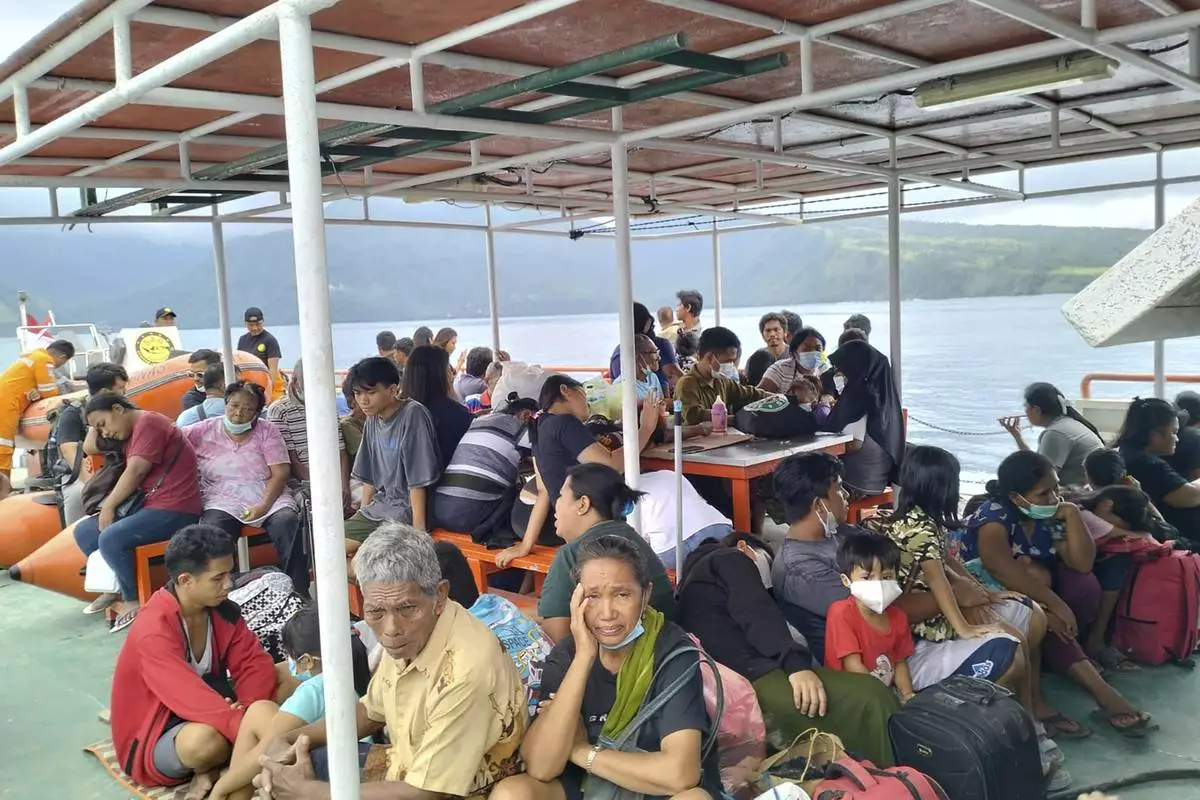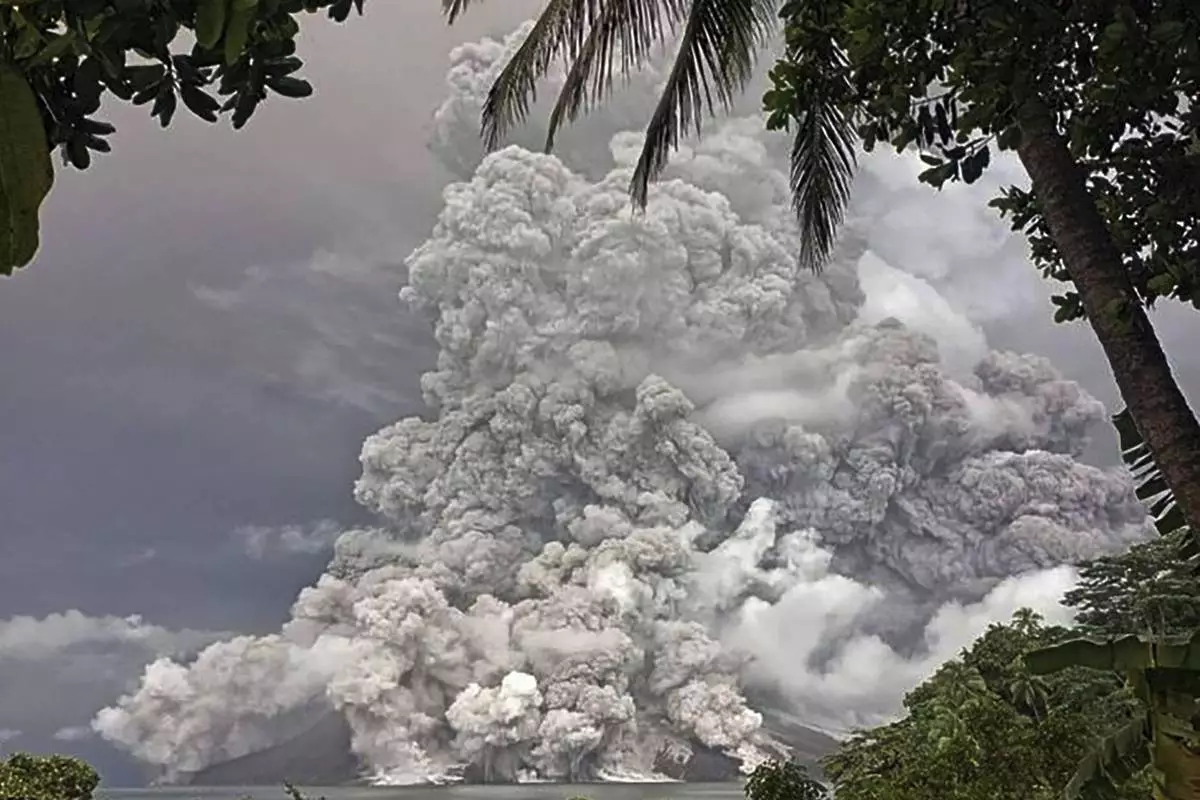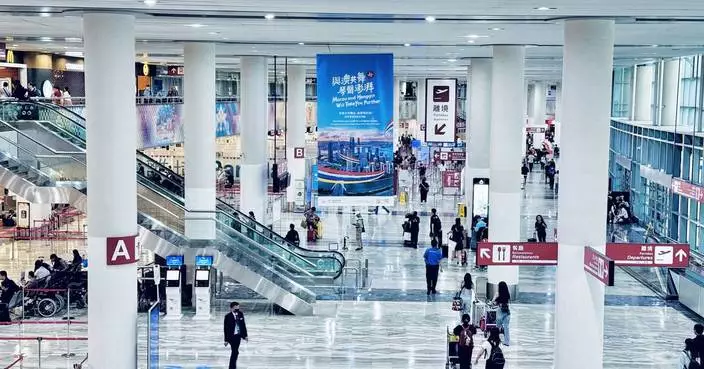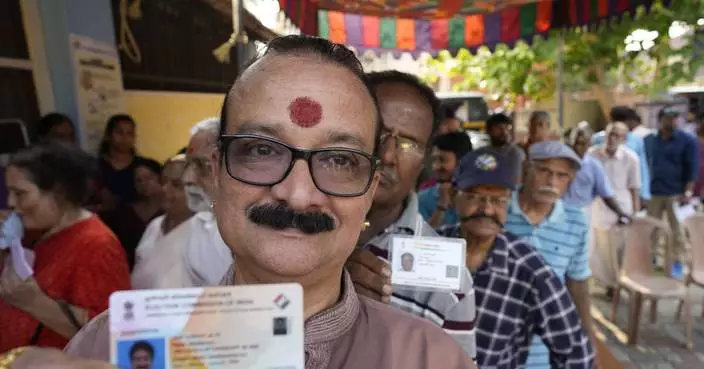Along a bustling road set amid a series of new McMansions in Kashmir's main city, a half-dozen extended families are camped in an open field in shelters of burlap and plastic. To an outsider, they look like refugees.
But they're not.
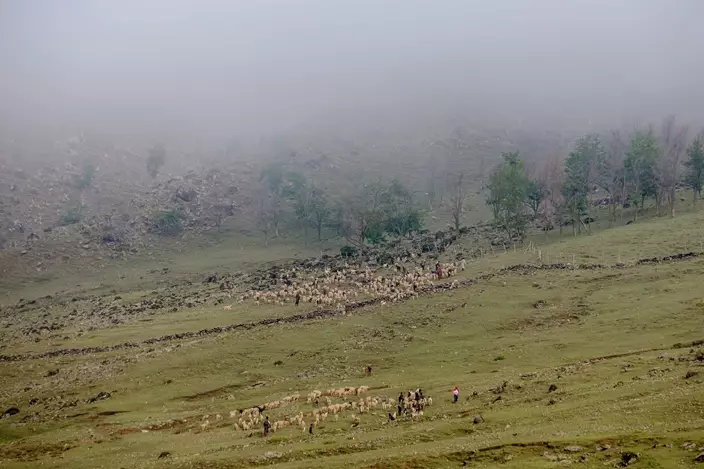
In this May 15, 2018 photo, Kashmiri nomadic Bakarwals lead the heard of sheep and goats at the base of a mountain pass on their way to Sonmarg, outskirts of Srinagar, Indian controlled Kashmir. (AP Photo/Dar Yasin)

In this May 11, 2018, photo, Mushtaq Khan, a Kashmiri nomadic Bakarwal groom poses for picture inside a tent at a camps in outskirts of Srinagar, Indian controlled Kashmir. (AP Photo/Dar Yasin)
They are nomads whose families have traveled for centuries between summer pastures in the Himalayas and winter grazing grounds in the lowland plains, herding their goats, sheep and horses.
The Muslim Bakarwal, who usually stop only briefly in Srinagar, have settled in for a few extra days this year for a community marriage. This group, of about 50 people, is traveling without their livestock, which others had already taken to the high pastures.

In this May 11, 2018, photo, relatives of Naseem Akhtar, a Kashmiri Bakrwal bride pray as she leaves her parents tent during a wedding ceremony in the outskirts of Srinagar, Indian controlled Kashmir. (AP Photo/Dar Yasin)

In this May 11, 2018, photo, Kashmiri Bakarwal nomads listen to a sermon delivered by a cleric during a marriage ceremony at a camp in the outskirts of Srinagar, Indian controlled Kashmir. (AP Photo/Dar Yasin)
"It's a life of hardship," said a 40-year-old man named Gami as he lit a cooking fire for the camp's wedding feast. "The skies above are hostile to us and so is the earth below. War, weather and wolf: All are hostile to us," said Gami, who uses only one name.
South of Srinagar, in another Bakarwal camp, Nasreen Bano was caring for her baby, born last week during a forest stopover. Two days later, she began the trek to join her husband, who was already in the highlands.

In this May 11, 2018, photo, photo, elderly Kashmiri nomadic Bakarwal men share a lighter moment as the smoke a hubble bubble or Hukka near a camp, outskirts of Srinagar, Indian controlled Kashmir. (AP Photo/Dar Yasin)
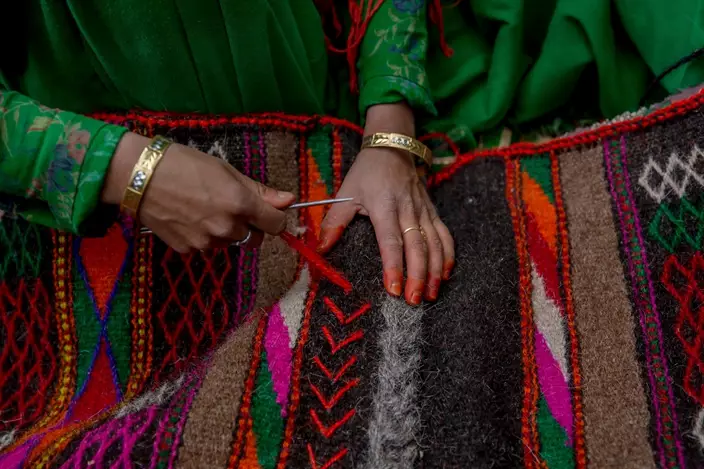
In this May 9, 2018, photo, a Kashmiri nomadic Bakarwal woman decorates a blanket made from goat hair outside her tent in Newa, 29 kilometers (18 miles) south of Srinagar, Indian controlled Kashmir. (AP Photo/Dar Yasin)
"This is how it goes," Bano said. "We keep moving, from one place to the other."
But life for the Bakarwal is changing. Cities are closing in on their grazing lands and traditional paths. Some of the 200,000 or so Bakarwal have begun building permanent homes, sometimes sparking hostility with people living in those areas, many of them Hindu.

In this May 9, 2018, photo, Dawood Khatana, a Kashmiri nomadic Bakarwal poses for a photograph at a camp in Newa, 29 kilometers (18 miles) south of Srinagar, Indian controlled Kashmir. (AP Photo/Dar Yasin)
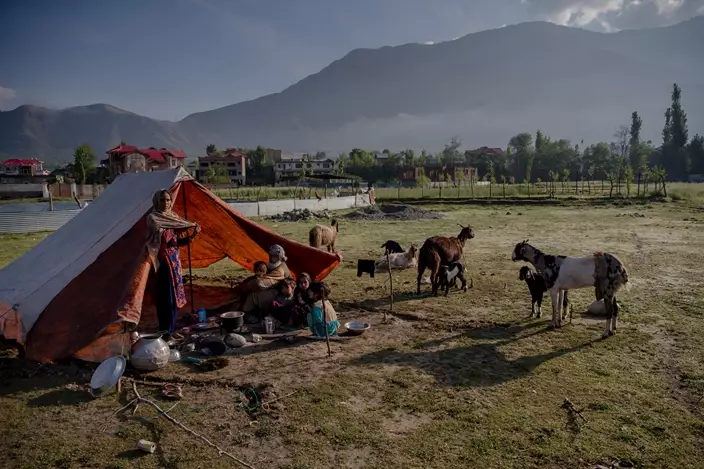
In this May 9, 2018, photo, a Kashmiri nomadic Bakarwal family camps in outskirts of Srinagar, Indian controlled Kashmir. (AP Photo/Dar Yasin)
That hostility turned to horror with the January gang-rape and killing of an 8-year-old Bakarwal girl, making the nomads wonder what sort of place they have in today's India.
"It's not the same for us anymore. Not only have our lives been made difficult because we've been restricted from moving freely, but now we're also under physical attack," said one Bakarwal, Mohammed Aslam, cutting mutton for the feast.
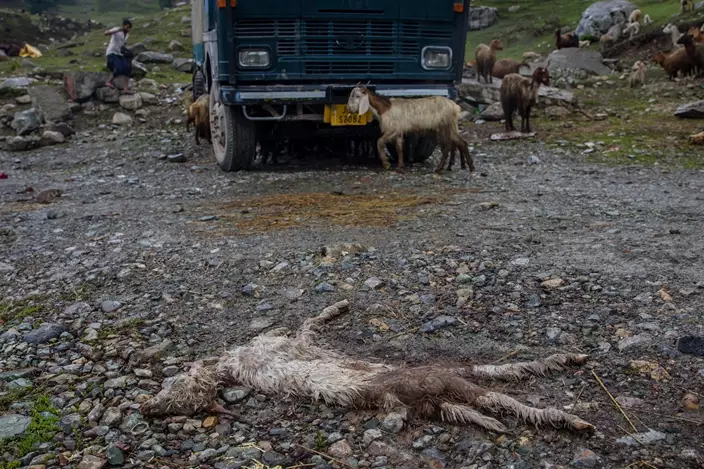
In this May 9, 2018, photo, a carcass of a lamb left behind by Kashmiri Bakarwals lies on a the road in Dubgan, 70 kilometers (43 miles) south of Srinagar, Indian controlled Kashmir. (AP Photo/Dar Yasin)
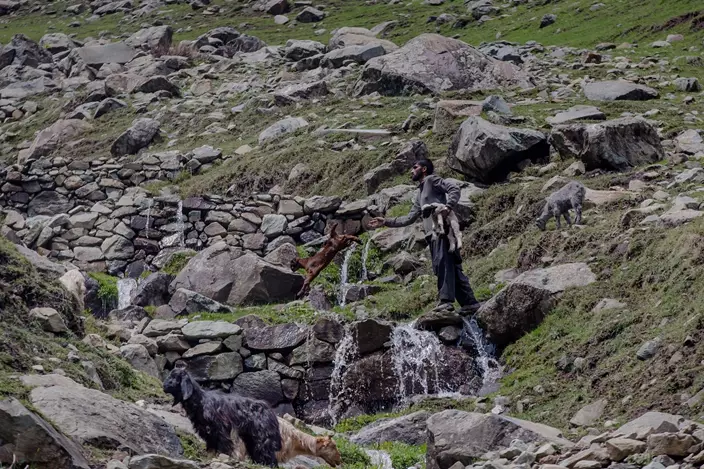
In this May 9, 2018, photo, a Kashmiri nomadic Bakarwal man carries a lamb as he tosses a baby goat to help them cross a waterfall near Dubgan, 70 kilometers (43 miles) south of Srinagar, Indian controlled Kashmir. (AP Photo/Dar Yasin)
Like many of India's religious minorities, particularly its Muslims, the Bakarwals have felt increasingly isolated as attacks by Hindu extremist groups have risen after the Hindu nationalist Bharatiya Janata Party, or BJP, was swept into power in India in 2014. The religious divide widened even further in Jammu-Kashmir state when the BJP formed a coalition government with a regional party. The Himalayan region of Kashmir is claimed in its entirety by both India and Pakistan but divided between them.
For the Bakarwal and other Muslim nomads, the trouble has often been about land.
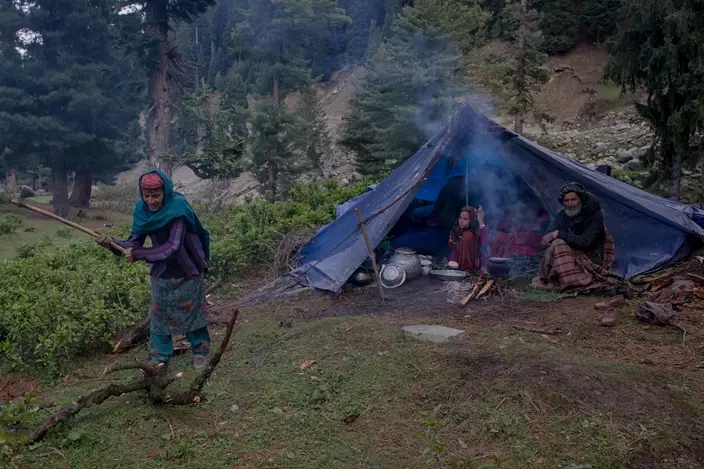
In this May 9, 2018, photo, Rashem Jan, a Kashmiri nomadic Bakarwal woman cuts a tree trunk for cooking food outside her tent at a temporary camp in Dubgan, 70 kilometers (43 miles) south of Srinagar, Indian controlled Kashmir. (AP Photo/Dar Yasin)
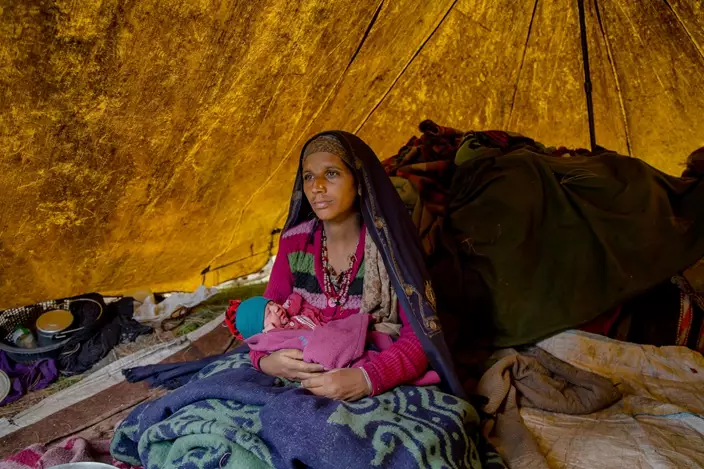
In this May 9, 2018, photo, Nasreen Bano, a Kashmiri nomadic Bakarwal woman poses for pictures along with her new born baby girl inside her tent at a temporary camp in Dubgan, 70 kilometers (43 miles) south of Srinagar, Indian controlled Kashmir. (AP Photo/Dar Yasin)
Much of that trouble has occurred around Jammu, the majority-Hindu city where the Bakarwals have their winter pastures. Hindu nationalists accuse the nomads of encroaching on their land when they build permanent homes, and say nomad leaders want to make the region majority-Muslim.
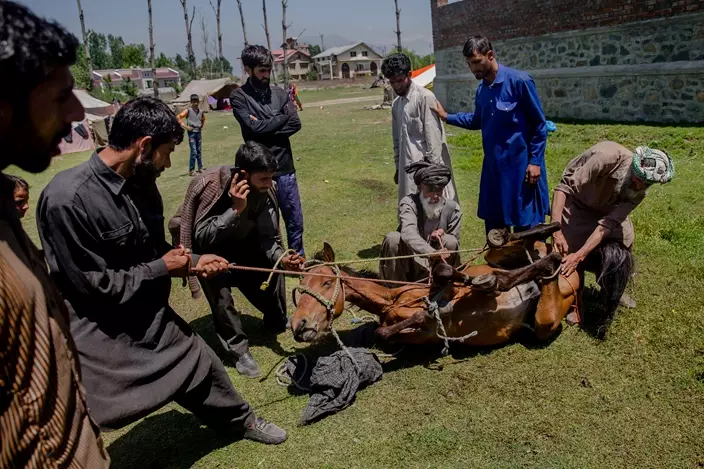
In this May 11, 2018, photo, Kashmiri nomadic Bakarwal men hold ropes tied to a horses as they castrate it using a traditional method that involves using hot iron rods at a camp on the outskirts of Srinagar, Indian controlled Kashmir. (AP Photo/Dar Yasin)
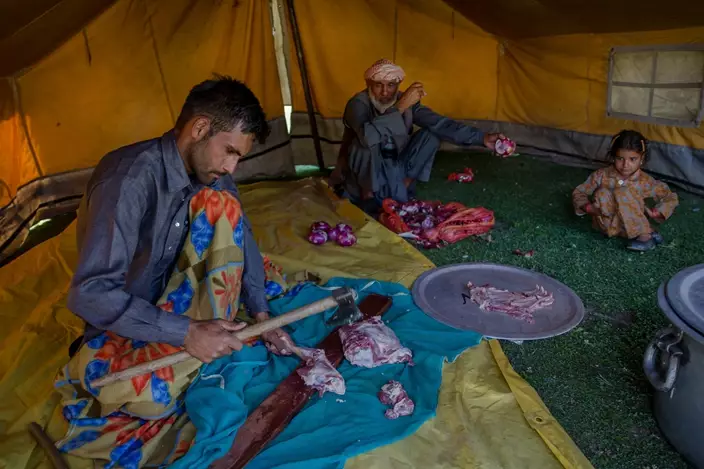
In this May 10, 2018, photo, Mohammad Aslam Khan, a Kashmiri nomadic Bakarwal cuts goat meat for a wedding feast at a camp in outskirts of Srinagar, Indian controlled Kashmir. (AP Photo/Dar Yasin)
Residents and forest officials have begun fencing in areas that have long been open, stopping the Bakarwal from reaching their traditional routes, pastures and water supplies. The tensions have led to scuffles, harassment of nomadic girls and, allegedly, the burning of nomad huts by Hindu men. In 2016, a young man was killed in a police shooting when Gujjars, another nomadic Muslim community, resisted police orders to leave their settlements near Jammu.

In this May 9, 2018, photo, Gul Khan, a Kashmiri nomadic Bakarwal man carries a tired goat on his shoulder as he leads a heard of sheep and goats at Peer Ki Gali, India, 80 kilometers (50 miles) south of Srinagar, Indian controlled Kashmir. (AP Photo/Dar Yasin)
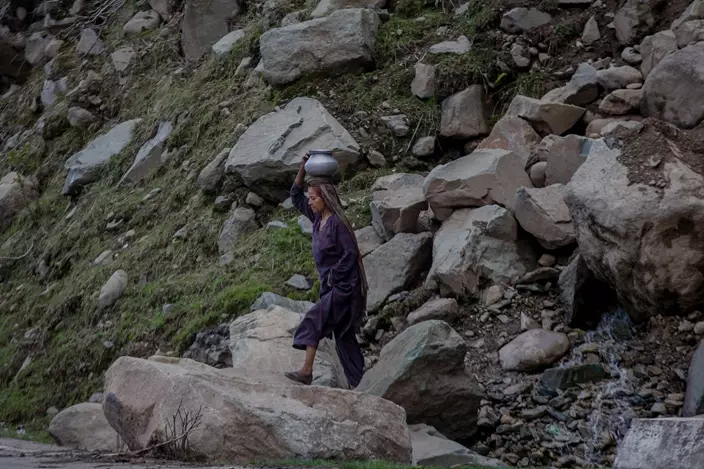
In this May 9, 2018, photo, a Kashmiri nomadic Bakarwal woman carries water after collecting it from a waterfall in Dubgan, 70 kilometers (43 miles) south of Srinagar, Indian controlled Kashmir. (AP Photo/Dar Yasin)
In January, the 8-year-old Bakarwal girl was grazing her family's ponies near the town of Kathua, a couple of hours from Jammu, when she was kidnapped. Her raped and mutilated body was found in the woods a week later. Eight people, including four police officials, have been arrested in the crime and destruction of evidence.

In this May 9, 2018, photo, Kashmiri nomadic Bakarwal men keep an eye on the heard of sheep and goats as they take shelter under a tree as it drizzles near Dubgan, 70 kilometers (43 miles) south of Srinagar, Indian controlled Kashmir. (AP Photo/Dar Yasin)
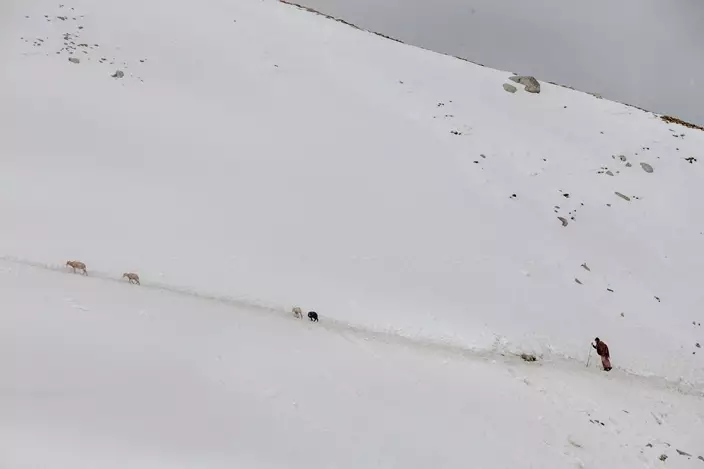
In this May 9, 2018, photo, Ghulam Nabi, a Kashmiri nomadic Bakarwal walks on a slippery snow covered mountain track as he tends to his 4 remaining sheep out of a heard of 50 sheep and goats which slipped to death on the same track at Peer Ki Gali, 80 kilometers (50 miles) south of Srinagar, Indian controlled Kashmir. (AP Photo/Dar Yasin)
A police probe revealed the attack had been planned for over a month as a way to terrify the Bakarwal into leaving the area. Then, thousands of members of a radical Hindu group with links to the ruling party marched to demand the release of the men accused in the attack, which happened inside a private Hindu temple. Hundreds of Hindu lawyers also protested that the men were innocent.
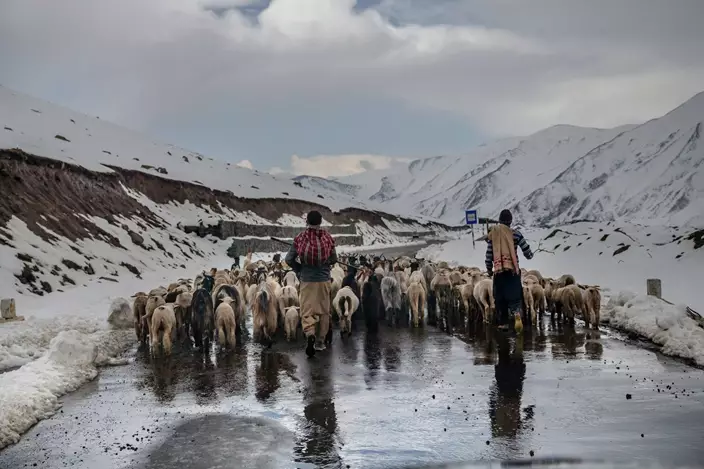
In this May 9, 2018, photo, Kashmiri nomadic Bakarwals walks with heard of sheep and goats near Peer Ki Gali, India, 80 kilometers (50 miles) south of Srinagar, Indian controlled Kashmir. (AP Photo/Dar Yasin)
"We keep on telling ourselves that this too will pass. And yes, it will," said Mohammed Latief, a young man who often works as a community cook. "But the prime concern is that our lives are fast changing. We're losing our Bakarwal culture to the modern world."
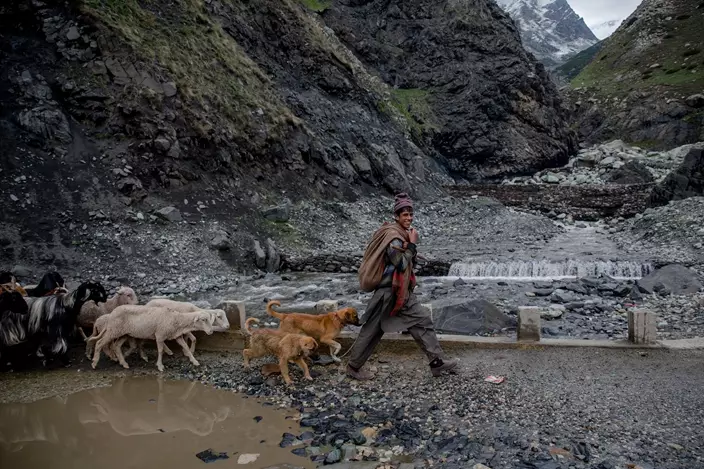
In this May 9, 2018, photo, a Kashmiri nomadic Bakarwal boy leads the heard of sheep and goats near Dubgan, 70 kilometers (43 miles) south of Srinagar, Indian controlled Kashmir. (AP Photo/Dar Yasin)
Javaid Rahi, who runs the Tribal Research and Cultural Foundation, a nonprofit group that studies the state's tribal people, agrees. He says many Bakarwal have left herding to become semiskilled laborers or beggars.
"This community is under immense pressure. They're being accused of forest encroachment. Their passages are being restricted and are subjected to communal attacks," Rahi said. "I'm afraid they'll soon be forced to abandon their core occupation of seasonal migration. In a decade or so, it'll be a history of past."




